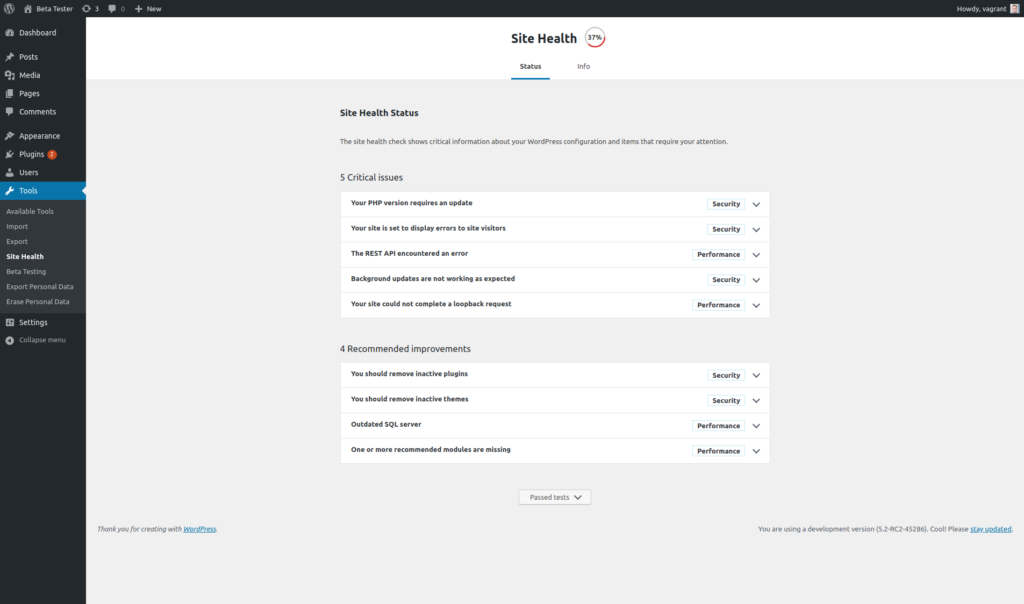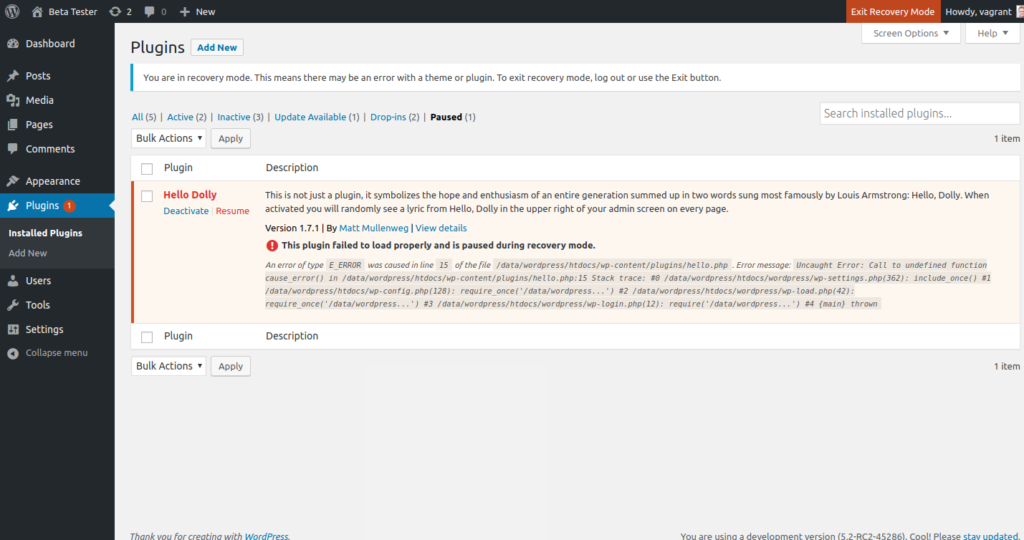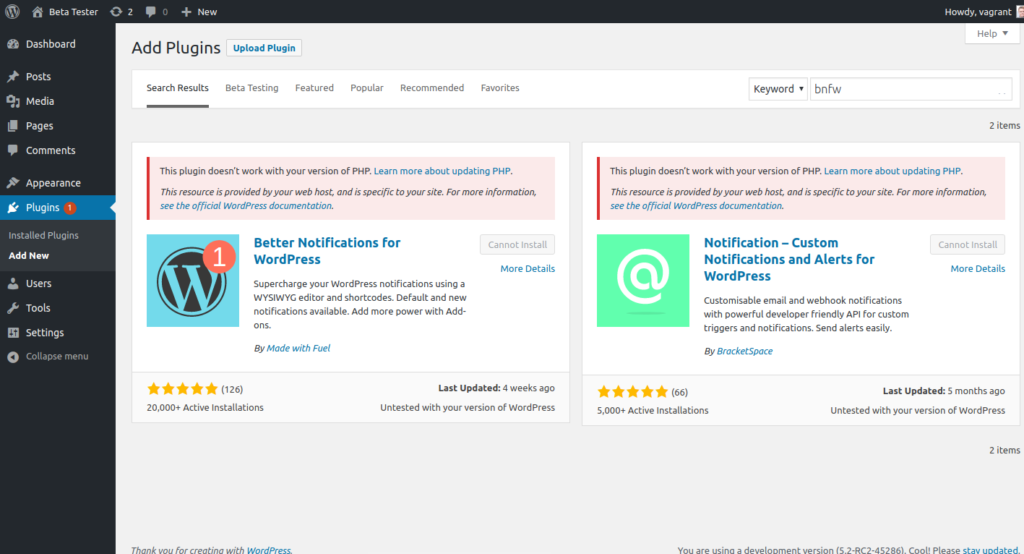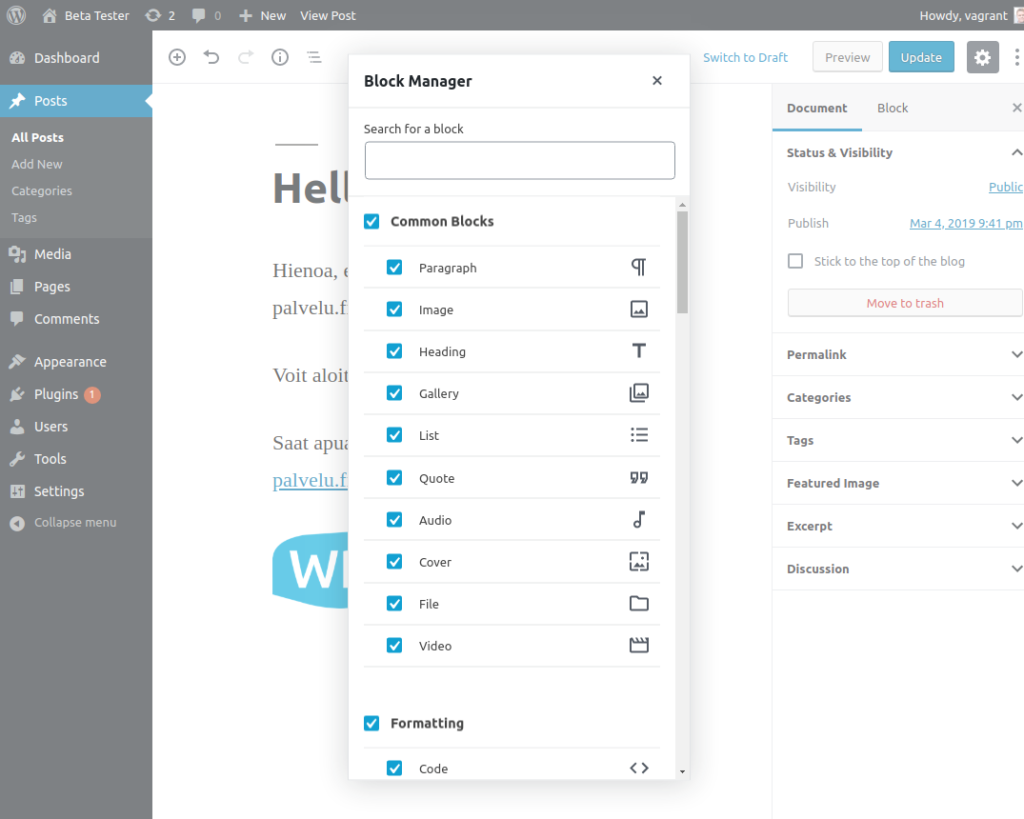WordPress 5.2 is the second major release for 2019 with a focus on site health, updated PHP requirements, PHP error protection, and improvements to the block editor.
New in wp-admin: Site Health
In the site_status_tests which means that plugins or themes can add their own tests, or remove existing ones.
The info tab is meant for debugging purposes and showing details about the configuration of your WordPress website. The page is broken down into different accordion styled sections. Also here you have the possibility to add or remove sections using the filter debug_information. The button “Copy site info to clipboard” makes it easy to share this information, for example with a plugin developer. This functionality doesn’t include information that could be considered private information. For instance, the entire database section is not included by default when using the copy functionality.
For more information about these features see the blog post “Site Health

Introduction of a Recovery Mode to Manage Fatal PHP Errors
The plan was initially to include this recovery mode already in the 5.1 release but it got pulled out in the last second due to security concerns.
If a fatal error occurs, a new error screen will be shown that informs the visitor that the site is experiencing technical difficulties. At the same time an email will be sent to the admin email address, informing about the issue and including a secret link to the new feature called the “recovery mode”.
This new recovery mode gives an administrator access to the wp-admin on a suspended site. They will see information about what is causing the issue and can for example deactivate the plugin causing the fatal error. Be aware that this recovery mode and pausing of plugins is only visible for the administrator when using the link, which actually sets a cookie in your client. Other visitors and users will still get the PHP error.
There are multiple ways to integrate with this functionality as a developer. For example, it’s possible to create a custom template error screen. Read more about that in the article “Fatal Error Recovery Mode in 5.2”.

PHP Requirements Finally Being Raised
Raising the minimum required PHP version for WordPress has been a topic of discussion within the community for a long time. Now it is finally happening. With WordPress 5.2 the minimum PHP version is coincidentally being raised from PHP 5.2.4+ to 5.6.20+. The plan, that can be read in the blog post “Updating the minimum PHP version”, is to continue to update the minimum version further and this can now also be done more safely with the inclusion of the PHP error protection and the Site Health features explained above.
This means that you will see the PHP update notice that was introduced in 5.1 if your site is using a PHP version below 5.6.20+. Updating WordPress will also not be possible if your PHP version is below the minimum requirement.
Plugin authors have also been able to define a required minimum PHP version since August 2017. This has now been enforced so that you cannot install or update any plugins from WordPress.org that require a higher PHP version than what you currently have. This check is however not implemented for plugins that are distributed outside of WordPress.org. That discussion will continue on the core ticket #40934.

Manage the Growing List of Blocks with the Block Manager and More
The block editor that was included in WordPress 5.0 continues to get improvements with every release. Technically the most significant update in this release is the addition of a reusable block-editor module that enables the possibility to use the block editor without any dependency to a post object. This will be used in the ongoing effort to bring the block editor to manage widgets and other parts of WordPress going forward.
One of the bigger visual things that you will see in the block editor is the inclusion of a new block manager that lets you as an editor manage the growing list of blocks available when editing pages and posts. You can hide entire sections or specific blocks. But as before as a developer you can still also programmatically, using filters, whitelist, blacklist or hide certain blocks as you want.
Other than this there is a new asynchronous mode for block rendering which speeds up the performance, new blocks for things like RSS feeds and Amazon Kindle embeds, as well as many other improvements. The block editor is continuously being improved with bi-weekly releases that you can start using directly by installing and acticating the Gutenberg plugin.

Also Improvements to Accessibility, Privacy Policy and Other Areas
There are also accessibility updates to eg the markup for Admin tabs, new features have been added to make customizing and designing the Privacy Policy page easier, and 13 new Dashicons.
The Sodium cryptography library has been included to secure WordPress against infrastructure attacks. As a developer you now have the possibility to better check for custom content relationships before a user is deleted from a site using the new users_have_additional_content filter.
There is also the addition of new wp_body_open hook which should for exampe make it easier to add Google Tag Manager support to your website. If you develop themes, please add this right away. Remember to wrap it with a check if the function exists so your theme won’t break using older WordPress releases. More information in this blog post. This addition is the result of a nine year open Trac ticket and a reminder similar to the minimum PHP version update that sometimes change takes time, a very long time.
What Does This Mean for Seravo Customers?
Seravo will update all customers running WordPress 5.0.x to the latest WordPress 5.2 version in the near future. Since 5.2 is not a security update, we will not rush these updates as we also anticipate that 5.2.1 will be released soon.
After your site has been updated to 5.2 you might notice a warning about “Background updates are not working as expected”. That is not something you need to worry about since it is something we manage for you with our own comprehensive update process.
As we have communicated in the 5.0 release post, we are currently not yet updating customers from WordPress 4.x versions to 5.x due to backwards incompatible changes with many plugins. As the WordPress ecosystem matures we will proceed with these updates as well.
So to summarize, as a Seravo customer you don’t need to worry about updates. We take care of them.
Further Reading
For more information around the release, look at the release post and the more developer-oriented Field Guide. A minor 5.2.1 update is expected shortly. The scope for 5.3 being is discussed at the moment and that update should come out after the summer 2019. Follow the WordPress core posts for updates on this.

